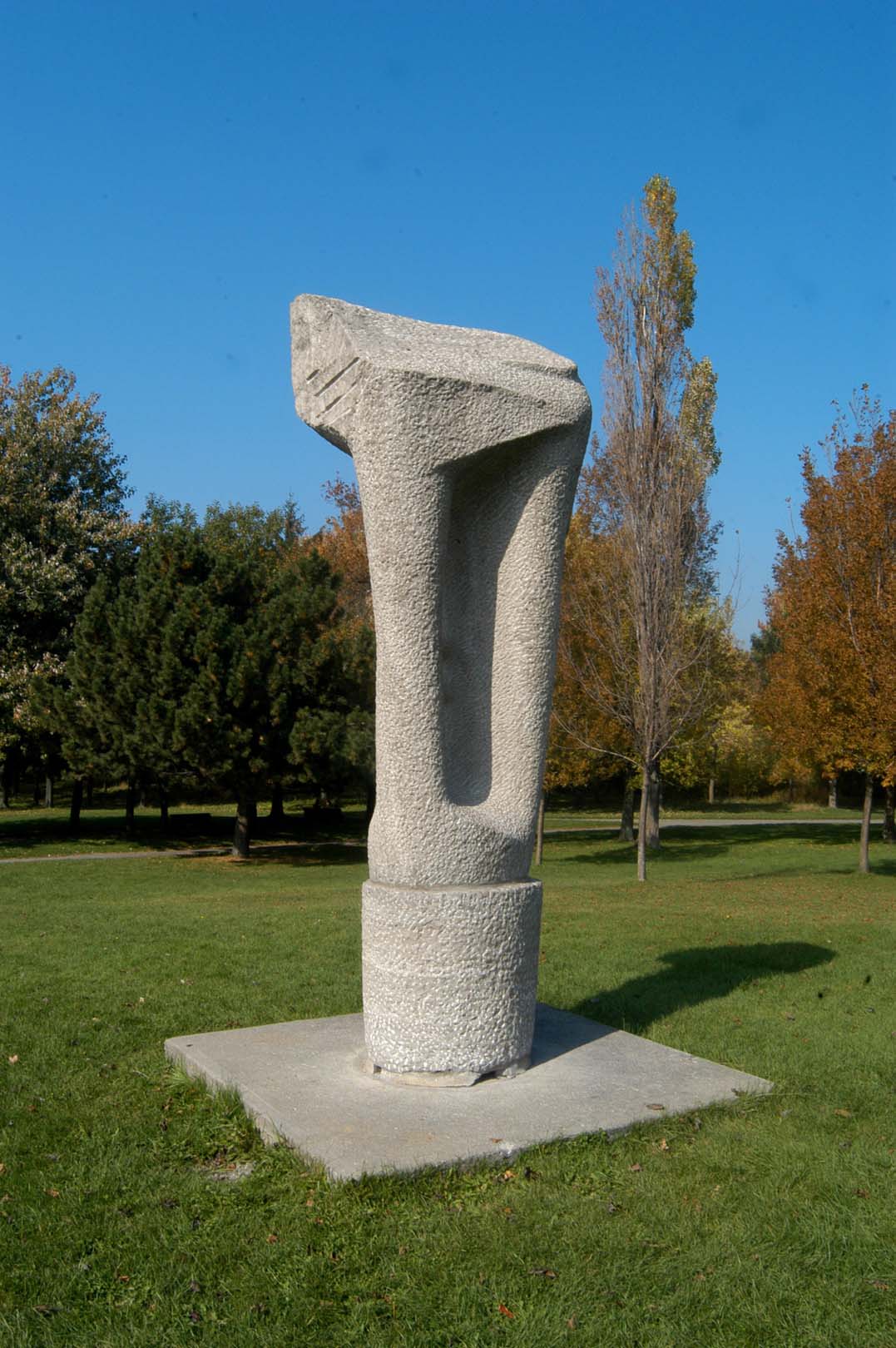Agustín Cárdenas
Sans titre
1964
Presentation of the artwork
From a concrete base rises an abstract sculpture formed of an elongated, pierced cylindrical stone mass. Situated near the other artworks produced for the event in Mount Royal Park, Agustín Cárdenas’s monumental sculpture is covered with a patterned finish that recalls the artist’s performance on the material, produced before an audience.The pointed top refers to the ramparts of a roofline and takes the form of a fragment of a eccentric temple, the rounded columns of which converge into a single piece. However, it is the biomorphic dimension of the work that dominates. In the view of Guy Viau, one of the Symposium organizers, the curves “suggest that the human body has been buried by osmosis in the stone and animates it by magic.” 1
This interpretation underlines the vaguely phantasmagorical impression that the artwork gives. Like the wooden “totems” that he produced throughout his career, the sinuous, mysteriously evocative lines of this sculpture recall Cárdenas’s surrealist roots in the 1950s, when he worked with André Breton.
1. Guy Viau, “Un symposium sur le Mont-Royal,” Vie des arts, no. 37 (1965): 28–31 (our translation).
Associated events
Cárdenas’s artwork was executed for the International Sculpture Symposium in Montréal (1964), the first time a symposium was held in North America. The goals of this concept, created a few years earlier in Europe, were to have artists create monumental sculptures in a context of encounters with the public and to provide public spaces with international-calibre artworks. Instigated by sculptor Robert Roussil, this symposium gathered 11 sculptors from nine countries and attracted more than 40,000 visitors. It was seen as one of the events that brought Québec into artistic and cultural modernity.
Agustín Cárdenas
Agustín Cárdenas was born in Cuba in 1927. He studied at the San Alejandro Academy of Fine Art and then emigrated to France in 1955. His career took a new turn and he subsequently travelled to Japan, Austria, and Israel, but most importantly to Italy, where he worked in stone and bronze.
Cardenas’s works are included in a number of public and private collections and on display in the public space, notably Antillean Couple (1957), in Philadelphia, and Porte d’Eau (1973), in Passy, France.
Cardenas’s works are included in a number of public and private collections and on display in the public space, notably Antillean Couple (1957), in Philadelphia, and Porte d’Eau (1973), in Passy, France.
Awards and honours
- prix Nacional de Artes Plásticas (Cuba), 1995
- Ordre des Arts et des Lettres (France), 1976
- prix Fujisankey Biennal, Hakone Open Air Museum, Fujisankey (Japon), 1976
- prix William Copley (new York), 1964
- prix de la sculpture de la Biennale de Paris, 1961
- médaille d'argent, XXXVII, Salón de Bellas Artes, Círculo de Bellas Artes (La Havane), 1955
- deuxième prix, VI Salón Nacional de Pintura y Escultura, Salones del Capitolio Nacional (La Havane), 1953
Presentation of the artwork
From a concrete base rises an abstract sculpture formed of an elongated, pierced cylindrical stone mass. Situated near the other artworks produced for the event in Mount Royal Park, Agustín Cárdenas’s monumental sculpture is covered with a patterned finish that recalls the artist’s performance on the material, produced before an audience.The pointed top refers to the ramparts of a roofline and takes the form of a fragment of a eccentric temple, the rounded columns of which converge into a single piece. However, it is the biomorphic dimension of the work that dominates. In the view of Guy Viau, one of the Symposium organizers, the curves “suggest that the human body has been buried by osmosis in the stone and animates it by magic.” 1
This interpretation underlines the vaguely phantasmagorical impression that the artwork gives. Like the wooden “totems” that he produced throughout his career, the sinuous, mysteriously evocative lines of this sculpture recall Cárdenas’s surrealist roots in the 1950s, when he worked with André Breton.
1. Guy Viau, “Un symposium sur le Mont-Royal,” Vie des arts, no. 37 (1965): 28–31 (our translation).
Associated events
Cárdenas’s artwork was executed for the International Sculpture Symposium in Montréal (1964), the first time a symposium was held in North America. The goals of this concept, created a few years earlier in Europe, were to have artists create monumental sculptures in a context of encounters with the public and to provide public spaces with international-calibre artworks. Instigated by sculptor Robert Roussil, this symposium gathered 11 sculptors from nine countries and attracted more than 40,000 visitors. It was seen as one of the events that brought Québec into artistic and cultural modernity.
Agustín Cárdenas
Agustín Cárdenas was born in Cuba in 1927. He studied at the San Alejandro Academy of Fine Art and then emigrated to France in 1955. His career took a new turn and he subsequently travelled to Japan, Austria, and Israel, but most importantly to Italy, where he worked in stone and bronze.
Cardenas’s works are included in a number of public and private collections and on display in the public space, notably Antillean Couple (1957), in Philadelphia, and Porte d’Eau (1973), in Passy, France.
Cardenas’s works are included in a number of public and private collections and on display in the public space, notably Antillean Couple (1957), in Philadelphia, and Porte d’Eau (1973), in Passy, France.
Awards and honours
- prix Nacional de Artes Plásticas (Cuba), 1995
- Ordre des Arts et des Lettres (France), 1976
- prix Fujisankey Biennal, Hakone Open Air Museum, Fujisankey (Japon), 1976
- prix William Copley (new York), 1964
- prix de la sculpture de la Biennale de Paris, 1961
- médaille d'argent, XXXVII, Salón de Bellas Artes, Círculo de Bellas Artes (La Havane), 1955
- deuxième prix, VI Salón Nacional de Pintura y Escultura, Salones del Capitolio Nacional (La Havane), 1953





